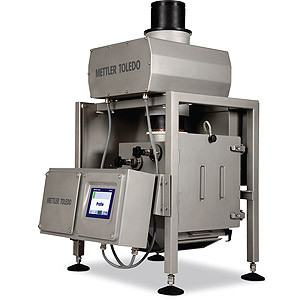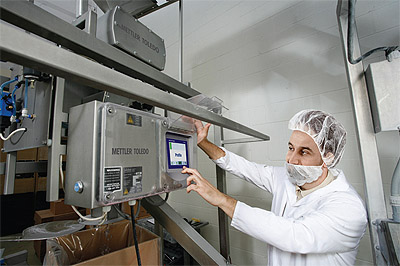Innovations in Metal Detection Technology
Food manufacturers are under significant pressure to increase productivity, reduce food waste, and meet strict food safety standards. This article explores some recent innovations in metal detection technology and explains how they deliver tangible benefits to improve efficiency and minimize downtime.
Routine performance monitoring testing is a challenge for food manufacturers
GFSI-based food safety standards and retailer codes of practice require frequent performance monitoring tests to verify that product inspection equipment is working as it should. The  frequency can vary depending on the application, and how long product stays on site before it is shipped to its destination. Bread manufacturers may test every 20 minutes, whereas longer intervals are acceptable in snack food manufacturing as product has a longer shelf life.
frequency can vary depending on the application, and how long product stays on site before it is shipped to its destination. Bread manufacturers may test every 20 minutes, whereas longer intervals are acceptable in snack food manufacturing as product has a longer shelf life.
The challenge certain manufacturers face is that every time a test is carried out there can be an impact on productivity and labour costs. Tests often require a stop in production, and multiple operators are required to physically carry out the tests. The higher the frequency of testing the bigger the impact it has on productivity and profitability, and the larger the volume of associated product waste.
How the latest metal detection innovations make routine testing easier
Mettler-Toledo Safeline has developed two new enhancements – Reduced Test (RT) Mode and the Automatic Test System (ATS) – designed to reduce the frequency of testing required and the time it takes to carry out the tests respectively in VFFS and free-fall applications.
Reduced Test (RT) Mode involves intelligent software that continuously checks the performance of the metal detector to ensure it is always working to, or better than, the customer’s required specification. Quality Managers are assured that the metal detector is always functioning correctly, and are alerted to any status changes that may lead to a drop in performance before it results in the metal detector operating out of specification.
Detectors are set to operate at a higher level of sensitivity than the customer needs to work to, creating a safety margin. Providing the system is operating within this safe zone, it is possible to significantly reduce the frequency of routine testing – by up to 83 per cent – as long as the actual test frequency remains within the quarantine period.
“Customers using Reduced Test Mode can significantly increase production capacity and reduce unnecessary product waste. One of our customers who used to test every two hours now tests every 12, and is reaping benefits of increased productivity and labour efficiencies, as well as a reduction in associated product waste. However, testing still takes between three and five minutes when it is necessary, and customers want to reduce this lost production time further, if possible,” says Mike Bradley, Head of Sales.
In response to this challenge, Mettler-Toledo developed the ATS. This system no longer requires an operator to physically insert test pieces into the product flow. ATS automatically introduces a number of test pieces into the metal detector’s aperture via a pneumatic system at the touch of a button. The whole testing process takes less than 40 seconds, as opposed to five minutes, and only requires one person to run the test, not two.
“Our customers have seen significant productivity and operator efficiency benefits, as well as enhanced worker safety due to a reduction in ladder climbs,” confirmed Bradley.
Drivers for Change
“Productivity and Overall Equipment Effectiveness (OEE) are two of the key drivers for our customers, alongside cost reduction. If a business can reduce costs and increase operator efficiency to allow them to carry out more production related functions, rather than test functions, there’s a direct correlation with profitability. Our latest enhancements as a whole deliver cost-down, productivity-up benefits, which aligns with the main business focus of many of our customers, “ Bradley explains.
More than just productivity benefits

We released two other innovations in 2017 – eDrive™ and Emulation. eDrive technology allows us to increase the amount of power to the transmit coil of the metal detector, making it easier to detect significantly smaller metal contaminants.
Fitted with eDrive, Mettler-Toledo’s latest throat metal detectors and gravity fall systems deliver up to 20 per cent increased spherical sensitivity. This translates into significantly improved non-spherical (wire type contamination) detection capabilities, enabling detection of lengths of wire up to 50 per cent shorter than previously possible. This enhances product quality, reduces the risk of product recalls and improves brand protection.
Emulation uses Virtual Network Computing (VNC) technology to enable operators to mirror the Human Machine Interface (HMI) of one or multiple Profile metal detectors onto remote networked devices, including mobile phones, tablets and laptops.
Quality personnel can log in remotely to monitor the current status of their metal detection programme, view any setting changes that have been made, and review performance monitoring statistics without having to be directly in front of the metal detector. In its simplest form, it can be considered a low cost ‘shop floor’ to ‘top floor’ monitoring process, allowing the organisation to effectively manage its Critical Control Points (CCPs).
These latest enhancements – RT mode, ATS, eDrive and Emulation – deliver significant productivity benefits, enhance product and process quality, increase levels of worker safety and ultimately help manufacturers protect their brand reputation.
Mettler-Toledo Safeline Ltd
Products: Metal detection solutions
